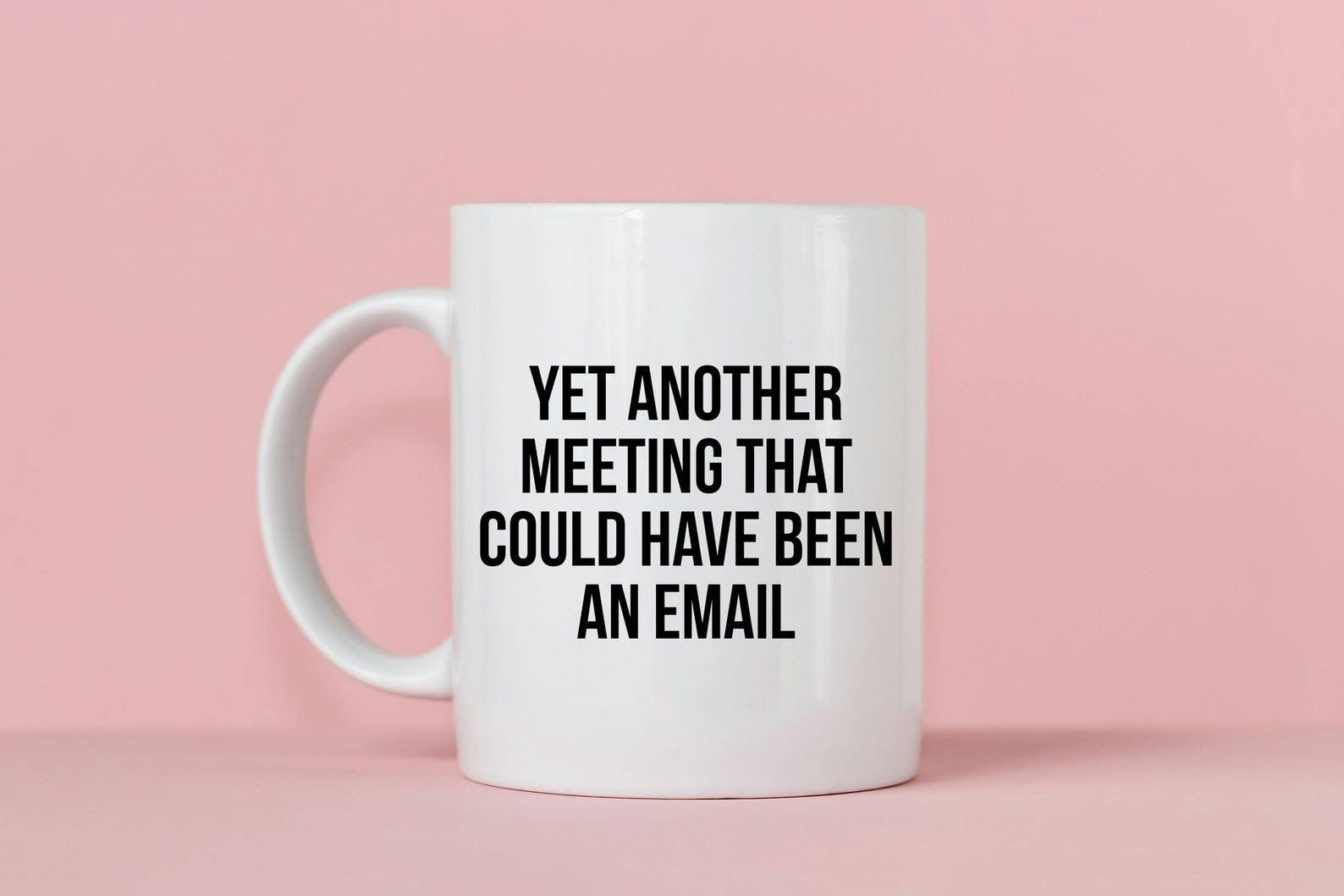That Meeting Should Have Been An Email: How To Solve It

Have you ever left a meeting thinking: That meeting could have been an email.”
We've all been there, especially if you've spent much time in an office.
However, some meetings should definitely be in person or synchronous over a conference call or video. But what meetings should actually be emails and what meetings should be meetings?
The number one benefit of remote work is flexibility. The flexibility to work where you want, at a time that makes sense for you, and the ability to build work around the realities of life.
The key to remote work:
- Flexibility of location
- Flexibility of working hours
- Flexibility to create around the realities of life
Does Zoom Fatigue Seem Like a Flexible Work Environment?
The question then is does Zoom and the complaints of Zoom fatigue seem like a flexible work environment?
And what about constant Slack notifications? How do we make sense of all the chat notifications and the noise in our everyday life. Those tools don’t even account for the other interruptions we get in our day: texts from friends and family, emails, and social media.
Do endless chat notifications and Zoom calls sound like a flexible working environment or is this a brittle working environment?
Here's the reality: most work environments still require constant presence.
Even though we've seen this massive shift from the office to remote, we're still running into this issue where we're not really tapping into the major benefit of what makes remote work so great. Here are a few of the remote work problems we're still experiencing.
1. The conveyor belt of workplace chat
There's this always-on conveyor belt mentality of workplace chat and the fear of missing out. You leave for a few minutes, you come back and there's a bunch of messages that you need to catch up on.
2. Continuous real-time meetings
Maybe you spend most of your day in meetings. Research indicates that the average person spends 10 to 20 percent of their week in meetings. If you run a team, it could be upwards of 50 percent. So that's a huge portion of your time spent where presence is required to get work done.
3. Virtual office environments that need constant presence
Now, we're seeing the rise of virtual office environments but even those require constant presence. They're aimed to boost collaboration but once again we're bound to be in the same place at the same time.
Reduce Dependency on The Real-Time Work Environment
How do you fix these issues? Reduce dependency on the real-time work environment.
The most important thing for companies to do is to create that flexible working environment that makes remote work so great. You can reduce your dependency on the real time environment to get work done. People need swim lanes for doing their best work and ideally you should really be thoughtful about when you communicate in real time and when you communicate asynchronously in a delayed or asynchronous way.
Not Another Meeting for Status Updates & Information Sharing?
Let's specifically unpack meetings a bit more. If you zoom in and think about most meetings that you have, especially the routine ones, they consist of two different components.
So oftentimes at the beginning of the meeting, especially these routine meetings, there's this element of information sharing.
We're bringing people up to speed with sharing metrics, basic facts and information, and most importantly status updates. You may have been in some meetings where you go around in a circle and you share one at a time what you're up to, then in the second half of the meeting you jump into more collaborative activities like resolving blockers, making decisions, and brainstorming around thorny issues. The Level 10 meeting agenda with metrics, “Rocks”, and decision making follows almost this exact format.
What about a mug like this?

What part of the meeting do people really dislike? Is it the collaborative nature or is it the stuff that involves that basic information sharing?
I would argue the information sharing.
If a meeting primarily consists of information sharing, it's probably a meeting that people say could have been an email.
Instead, what if the information was shared before the meeting starts? Then team members could walk into a meeting and we have a general understanding of what was going on--such as the reporting metrics. This provides a foundation for rich discussion and collaboration and less
less time giving status updates and doing the boring stuff. More time and attention can be allocated to relationship building, removing those blockers and ambiguity.
The Superpowers of Asynchronous Communication
Turns out, this approach actually works. At Friday, we see it with our customers almost everyday. Specifically asynchronous communication or written communication has a few different superpowers that real-time communication doesn't
1. Ability to edit and revise for clarity
Team members can give more thoughtful responses because they have extra time to consider their replies, rather than only offering their spontaneous feedback.
2. Asynchronous communication persists
An asynchronous response is easier to refer back to and can be referenced later. It’s simpler to index and search written communication than even an audio or video recording. You can
reference it later and it can help you resolve the ambiguity long after the meeting occurs.
Written communication is also easily skimmable. If you've ever sat in a meeting to give status updates oftentimes half of the updates that are given have very little relevance to you in your day, but sometimes a few things do. If you can skim over the update before the meeting, you can identify the things that you need clarification on.
3. More Inclusive
Additionally asynchronous meeting updates are more inclusive. People can write that update before they walk in and you won't be interrupted, because you're writing it down beforehand.
If you shared information before the meeting, it would dramatically reduce the amount of time you spend in meetings and help you create a more flexible workplace.

Async Meeting Playbooks To Use Instead Of An In-Person Meeting
Thinking at a high-level, think about how you could cut these meetings in half. Using a synchronous communication to share the information and the updates beforehand, the first thing I would recommend is analyze the meeting structure.
Different routine meetings have different information with a purpose and/or job that they aim to accomplish. These aims vary, so you need to think about the meeting itself and ask:
- What is the outcome of this routine meeting?
- What framework can I create for getting that information asynchronously?
A lot of people will ask for agenda items before the meeting. While that's a stepping stone
towards a better meeting, I would argue it's not it doesn't go as far as it should. The reasoning is because if you add agenda items to a document, what it essentially is doing is allocating a placeholder for bringing up that conversation in a meeting.
That is fine, but if it's just information sharing, it creates ambiguity and people have to clarify.
Instead, if you ask:
- What did you accomplish this week
- What are you working on next week
With those questions, people respond with proactive statements. It gives you additional levels of richness.
I would also recommend automating as much of the process as possible. How?
- Use tools like Zapier to create calendar reminders.
- Get that update delivered an hour before your meeting so then the whole team can read the updates beforehand. If you don't think you can pull that off, just allocate the first five minutes to review the written update before you jump into the real-time meeting.
1. Monday Kick-Off Meeting
For a more specific playbook, we would recommend a Monday kickoff meeting or prioritization meeting.
It's a forward-looking event that is run on Monday mornings where your team answers a few questions. Think of it like at a daily standup but for the week.
Run this on a Monday morning and ask a couple questions:
- How was your weekend?
- What do you need to accomplish this week?
When people share what they aim to accomplish for the week, it helps create a little bit of accountability and it sets an expectation especially for the team leader on what the output should be at the end of the week.
It also mixes in a little bit of fun because you can quickly catch up on when a co-worker did this really fun activity over the weekend, which can jumpstart those meeting conversations.
2. Daily Stand-ups
Another easy routine meeting is a daily stand-up. A lot of teams and companies are doing this now already.
These are the typical stand-up questions:
• What did you do yesterday?
• What are you working on today?
• Do you have any blockers?
• Do you have anything else you'd like to share?
That last question in particular is really really important because it gives each person the space to quickly share what's going on in their life--such as doing errands at 1pm. This helps set expectations and identify potential roadblocks faster. It helps you feel more connected.
This is the bare minimum amount of presence necessary to feel connected.
3. Weekly Recap & Status Update
The third meeting type is a recap at the end of the week. Consider doing this on a Friday morning or afternoon.
The questions could include:
- What did you accomplish this week? It allows the person to look back at their week and share if they hit that goal or not. It's a self-reflective process.
- How productive were you this week?
- Anything else you would like to share?
These questions create reflection and a checkpoint on the accomplishments and for output so you can create a more results-based work environment instead of requiring meetings to figure out if people are living up to what they said they would do.
4. One-on-One Meeting
The fourth meeting is a one-on-one meeting. I can't tell you how many times I have led or been in a one-on-one meeting where the first 15 to 20 minutes of that meeting is spent where you're trying to figure out what's going on with the employee.
Maybe if you ask a few questions beforehand in an asynchronous format you can collect this information. People are more honest behind a screen. Use this to your advantage to kick start better and more engaging real-time conversations.
Here are a few questions here you can ask:
• On a scale of 1-10, how are you feeling?
• What's the best part of your week?
• What can I help you with?
• What would you like to discuss?
5. Staff Meeting / All-Hands Meeting
The fifth and final playbook is for a leader or a CEO consider running this at the end of the week or maybe at the beginning of the next week. This is similar to the weekly recap, but for the company at-large.
- What emoji would you describe your week?
- How are we tracking on key goals or initiatives?
- What's top of mind?
This is kind of a complement to an all-hands meeting and it's a way to help align the team without the need to hold a brittle real-time meeting.
Think About Your Communication Channel
Meetings are best for collaboration, relationship building and removing ambiguity. If you are just using a meeting to share information that is probably a meeting that could have been an email or an asynchronous update.
This matrix is to help give you a basic framework for thinking about when you should have a meeting or when you should use a different communication channel for the task at hand.
Think about: What is the working relationship with the person or the people that I am thinking about meeting with?
- Is it strong or weak?
- Do I know this person well or do I not?
The second vector is the type of conversation. Is this a topic with low ambiguity or is it a very collaborative item?
When there's a lot of moving pieces that need to be resolved, you will probably need an in-person or synchronous meeting. If the working relationship is weak and if the conversation is somewhat unclear or ambiguous, you should probably have a real-time meeting for that.
Save your real-time conversations for when they fit that mold. If you have a strong working relationship if you've gotten to know the people, and it's a little bit unclear maybe consider using a tool like Loom where you are able to express yourself over video but in an asynchronous format.
If you have a clear conversation type like updates and you have a weak tie with the individuals consider using email but maybe consider using Slack instead.
Slack is a richer communication channel. It allows for emojis and it helps you kind of process in real time you know people's emotions in a way that an email doesn't.
If the conversation type is clear i.e facts and information once again and you have a strong relationship with your team, consider using something like a wiki to help you share those updates asynchronously.
You will spend a lot less time in meetings. The meetings that you have will be meetings that should really exist and then you can build a more flexible workplace.



